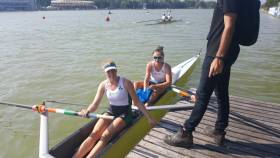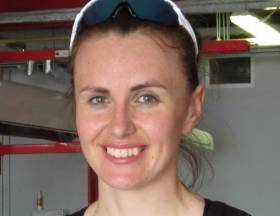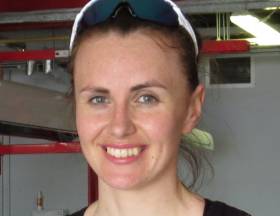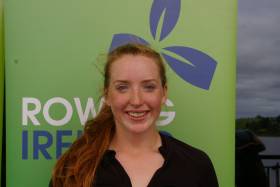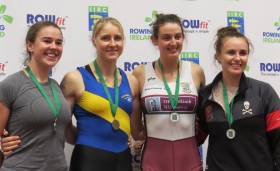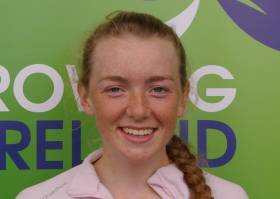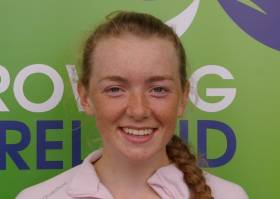Displaying items by tag: Emily Hegarty
Brilliant Finish Takes Ireland Women's Pair To World Championships Final
#Rowing: Aifric Keogh an Emily Hegarty produced a stunning final 500 metres to win their semi-final of the pair and qualify for the A Final at the World Rowing Championships in Plovdiv. The race was being fought out between Spain Britain and Italy, with Ireland fifth for most of the 2,000 metres. But then came that sprint. Ireland swept through the places; Britain fell back. Ireland won, with Italy and Spain taking the other A Final spots.
Earlier the men's double of Philip Doyle and Ronan Byrne had also qualfied for their A Final.
World Rowing Championships, Plovdiv, Bulgaria, Day Five (Irish interest)
Men
Pair – Quarter-Final Four (Three to A/B Semi-Finals; rest to C/D Semi-Finals): 1 Canada 6:26.04, 2 New Zealand 6:30.36, 3 Czech Republic 6:35.01; 5 Ireland (M O’Donovan, S O’Driscoll) 6:44.28.
Double Sculls – Repechage Four (First Two to A/B Semi-Final):
Ireland (P Doyle, R Byrne) 6:16.96, 2 Bulgaria 6:20.15.
Women
Pair – Semi-Final (Three to A Final; rest to B Final): 1 Ireland (A Keogh, E Hegarty) 7:14.67, 2 Italy 7:14.99, 3 Spain 7:15.30.
Keogh and Hegarty Give Ireland Good Start at World Rowing Championships
#Rowing: Ireland’s Aifric Keogh and Emily Hegarty took an excellent second place to qualify for the semi-finals on the first day of the World Rowing Championships in Plovdiv, Bulgaria.
The New Zealand pair of Kerri Gowler and Grace Prendergast are the best in the world at the moment: they are world champions and holders of the world's best time. They showed it by flying away from the field and winning well. There were two other direct qualification places on offer, with Australia, Ireland and the United States contending for them.
The United States were second to half way, but by then Keogh and Hegarty were moving. They pulled out a good third quarter and were virtually level with the Americans at 1500 metres. They pushed into second and secured their place in the next round. The American crew of Victoria Opitz and Gia Doonan were third.
World Rowing Championships, Plovdiv, Bulgaria, Day One (Irish interest)
Women
Pair – Heat One (First Three to A/B Semi-Final; rest to Repechage): 1 New Zealand 6:56.06, 2 Ireland (A Keogh, E Hegarty) 7:11.51, 3 United States 7:13.02.
#Rowing: Emily Hegarty and Aifric Keogh took fourth in their semi-final of the women’s pair at the World Cup Regatta in Belgrade. The two UCC women closed hard in the closing stages on Britain Two, but the British crew of Emily Ford and Emily Ashford held on to the third place which sends them to the A Final. Spain won from Denmark.
The result for the Ireland double of Monika Dukarska and Aileen Crowley was the same. They started well in their semi-final and led to the 500 metre mark. The Netherlands and Belarus One took over and held those places to the end. Belarus Two established themselves in the third qualification spot and Dukarska and Crowley, who finished fast, could not dislodge the second Belarus boat.
The Ireland pair and double will compete in B Finals.
World Cup Regatta, Belgrade, Day Two (Irish interest)
Men
Pair – C Final (Places 13 to 18): 1 Hungary 6:55.35, 2 Greece 6:57.73, 3 Ireland (M O’Donovan, S O’Driscoll) 6:59.0, 4 South Africa 7:00.22.
Women
Pair – Semi-Final Two (Three to A Final; rest to B Final): 1 Spain 7:35.18, 2 Denmark 7:35.77, 3 Britain Two 7:39.35; 4 Ireland (A Keogh, E Hegarty) 7:42.60.
Double Sculls – Semi-Final (Three to A Final; rest to B Final): Netherlands 7:16.27, 2 Belarus One 7:18.73, 3 Belarus Two 7:23.46; 4 Ireland (A Crowley, M Dukarska) 7:25.60.
Hegarty (19) Takes Bronze Medal at International Rowing Regatta
#Rowing: Emily Hegarty took a bronze medal at the Memorial Paolo d’Aloja international regatta in Piediluco in Italy this morning. The UCC woman, who is 19, showed great belief in herself to take third place and hold it in a race dominated by Diana Dymchenko of the Ukraine. Lina Saltyte of Lithuania, an established international, took the silver.
Memorial Paolo d’Aloja International Regatta, Piediluco, Italy (Irish interest)
Sunday
Women
Single Sculls – A Final: 1 Ukraine (D Dymchenko) 7:52.35, 2 Lithuania (L Saltyte) 8:11.90, 3 Ireland (E Hegarty) 8:14.76.
Puspure Wins Single Sculls Heat in Italy
#Rowing: Sanita Puspure won her heat of the single sculls at the Memorial Paolo d’Aloja regatta in Italy, qualifying for Saturday’s A Final. The Ireland sculler had over a second to spare over second-placed Milda Valciukaite of Lithuania, an Olympic bronze medallist in the double in 2016. Emily Hegarty and Aifric Keogh qualified for the A Final of the pair with third in their heat, while Monika Dukarska and Aileen Crowley won a three-boat exhibition race in the women’s double.
Puspure Honoured as Women Produce Good Results
#Rowing: The Afloat Rower of the Month for January is Sanita Puspure. The Old Collegians competitor produced a creditable time of six minutes 39.8 seconds for 2,000 metres at the Irish Indoor Rowing Championships. Sam McKeown beat his own time to set a new record of 5:53.0 and lead the men’s rankings, while Puspure headed up a good set of performances by women. Aileen Crowley, Emily Hegarty, Aifric Keogh and Fiona Murtagh all recorded figures under seven minutes.
Rower of the Month awards: The judging panel is made up of Liam Gorman, rowing correspondent of The Irish Times and David O'Brien, Editor of Afloat magazine. Monthly awards for achievements during the year will appear on afloat.ie. Keep an eye on progress and watch our 2018 champions list grow.
O'Donovans Return With a Win
#Rowing: Paul and Gary O'Donovan won the doubles final at the Irish Open Regatta at the National Rowing Centre today. The Olympic silver medallists were given a tough race by Shane O'Driscoll and Mark O'Donovan, who led coming up to half way, only to see the O'Donovan brothers find a new gear to move away and win well.
The women's double went to the novel combination of Sanita Puspure (34) and Emily Hegarty (18). Even though well clear of the field, they powered home with impressive style.
Irish Open Rowing Championships, National Rowing Centre (Selected Results; graded on top times from heats)
Men
Eight - 1 NUIG, Grainne Mhaol (sen) 6:08, 2 UCC, Shandon (sen) 6:17, 3 NUIG, Grainne Mhaol (u23) 6:21.
Four - 1 UCD (E Gleeson, R Thompson, S Mulvaney, D O'Malley; under-23) 6:34, 2 Trinity, UCD (senior) 6:40, 3 Commercial (junior) 6:57.
Quadruple - 1 Clonmel, UCC, Shandon (J Casey, D Begley, R Byrne, D Lynch; u23) 6:28, 2 Queen's, Castleconnell (sen) 6:33, 3 Carlow, Clonmel, Cork (jun) 6:36.
Double - 1 Skibbereen, UCD (G O'Donovan, P O'Donovan; sen) 6:39, 2 Skibbereen (sen) 6:45, 3 Skibbereen (u23) 6:48; 7 Three Castles A (jun) 7:05.
Women
Eight - 1 NUIG (sen) 7:22.
Four - 1 Cork, Skibbereen (T Hanlon, A Mason, N Casey, E Cialis; u23) 7:37, 2 Queen's, Belfast BC, Methodist (sen) 7:42, 3 Commercial (jun) 7:51.
Quadruple - 1 UCD, Queen's, Fermoy (E Lambe, S Bouanane, O Blundell, A Crowley; sen) 7:24, 2 Cork, Kenmare (jun) 7:42, 3 Lee Skibbereen (sen) 7:50.
Double - 1 Old Collegians, Skibbereen (S Puspure, E Hegarty; senior) 7:29, 2 Skibbereen (sen) 7:41, 3 Lee A (jun) 7:55; 9 UCD, Belfast (u23) 8:16.
Hegarty and Casey Battle it Out in B Final at World Rowing
#Rowing: Ireland's junior women's double of Aoife Casey and Emily Hegarty finished sixth in the B Final of the World Rowing Chmpionships this morning. The race featured a battle of wills over most of the course between leaders France and challengers Spain. The Spaniards came through to win. Ireland and New Zealand battled to take fifth, with New Zealand taking it by just over a second.
The programme had to be postponed twice because of thunder and lightning storms. There was a strong tailwind, but the course was deemed fair and lanes were not redrawn as they had been on the Saturday.
World Rowing Championships, Rotterdam (Irish interest; Selected Results)
Women
Junior Double Sculls - B Final (Places 7 to 12): 1 Spain 7:13.72; 6 Ireland (A Casey, E Hegarty) 7:22.68.
Ireland Junior Women Set For World Rowing Repechage
#Rowing: Ireland’s Emily Hegarty and Aoife Casey finished fourth in their heat of the junior women’s double at the World Rowing Championships in Rotterdam today. Just one crew from the heat qualified directly for the A/B semi-finals, with the rest dropping into repechages. France and the United States contended for the crucial first place early on, but France could not live with the pace set by the Americans, who won. Canada took third behind France and Casey and Hegarty the next spot.
World Rowing Championships, Rotterdam (Irish interest, selected results)
Men
Junior Double Sculls - Heat Five (Four to Quarter-Finals; rest to repechage): New Zealand 6:28.44, 2 Ireland (R Byrne, D Lynch) 6:33.28, 3 Belarus 6:33.35, 4 South Africa 6:37.82.
Women
Junior Double Sculls - Heat One (Winner to A/B Semi-Final; rest to Repechage): 1 United States 7:08.57; 4 Ireland (A Casey, E Hegarty) 7:25.93.



























